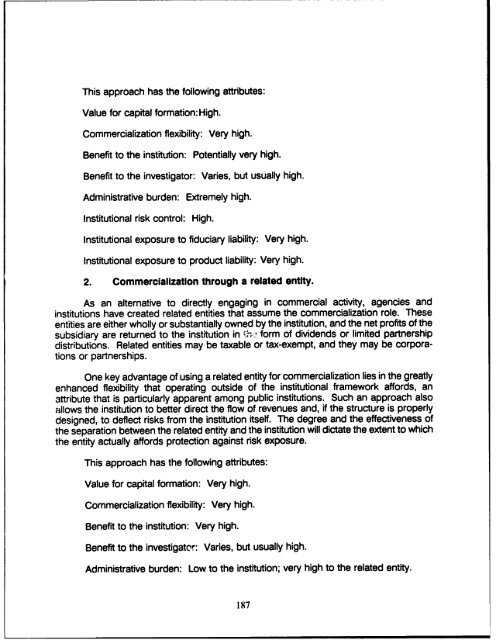Challenges and Opportunities for Innovation in the Public Works ...
Challenges and Opportunities for Innovation in the Public Works ...
Challenges and Opportunities for Innovation in the Public Works ...
Create successful ePaper yourself
Turn your PDF publications into a flip-book with our unique Google optimized e-Paper software.
This approach has <strong>the</strong> follow<strong>in</strong>g attributes:<br />
Value <strong>for</strong> capital <strong>for</strong>mation:High.<br />
Commercialization flexibility: Very high.<br />
Benefit to <strong>the</strong> <strong>in</strong>stitution: Potentially very high.<br />
Benefit to <strong>the</strong> <strong>in</strong>vestigator: Varies, but usually high.<br />
Adm<strong>in</strong>istrative burden: Extremely high.<br />
Institutional risk control: High.<br />
Institutional exposure to fiduciary liability: Very high.<br />
Institutional exposure to product liability: Very high.<br />
2. Commercialization through a related entity.<br />
As an alternative to directly engag<strong>in</strong>g <strong>in</strong> commercial activity, agencies <strong>and</strong><br />
<strong>in</strong>stitutions have created related entities that assume <strong>the</strong> commercialization role. These<br />
entities are ei<strong>the</strong>r wholly or substantially owned by <strong>the</strong> <strong>in</strong>stitution, <strong>and</strong> <strong>the</strong> net profits of <strong>the</strong><br />
subsidiary are returned to <strong>the</strong> <strong>in</strong>stitution <strong>in</strong> , <strong>for</strong>m of dividends or limited partnership<br />
distributions. Related entities may be taxable or tax-exempt, <strong>and</strong> <strong>the</strong>y may be corporations<br />
or partnerships.<br />
One key advantage of us<strong>in</strong>g a related entity <strong>for</strong> commercialization lies <strong>in</strong> <strong>the</strong> greatly<br />
enhanced flexibility that operat<strong>in</strong>g outside of <strong>the</strong> <strong>in</strong>stitutional framework af<strong>for</strong>ds, an<br />
attribute that is particularly apparent among public <strong>in</strong>stitutions. Such an approach also<br />
allows <strong>the</strong> <strong>in</strong>stitution to better direct <strong>the</strong> flow of revenues <strong>and</strong>, if <strong>the</strong> structure is properly<br />
designed, to deflect risks from <strong>the</strong> <strong>in</strong>stitution itself. The degree <strong>and</strong> <strong>the</strong> effectiveness of<br />
<strong>the</strong> separation between <strong>the</strong> related entity <strong>and</strong> <strong>the</strong> <strong>in</strong>stitution will dictate <strong>the</strong> extent to which<br />
<strong>the</strong> entity actually af<strong>for</strong>ds protection aga<strong>in</strong>st risk exposure.<br />
This approach has <strong>the</strong> follow<strong>in</strong>g attributes:<br />
Value <strong>for</strong> capital <strong>for</strong>mation: Very high.<br />
Commercialization flexibility: Very high.<br />
Benefit to <strong>the</strong> <strong>in</strong>stitution: Very high.<br />
Benefit to <strong>the</strong> <strong>in</strong>vestigator: Varies, but usually high.<br />
Adm<strong>in</strong>istrative burden: Low to <strong>the</strong> <strong>in</strong>stitution; very high to <strong>the</strong> related entity.<br />
187







